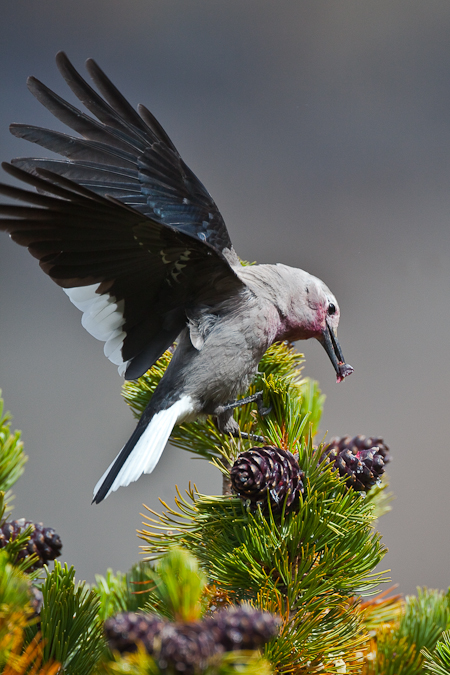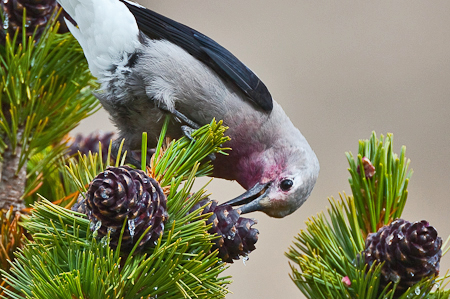 A Clark’s Nutcracker, face stained red (I’m not sure why), using its sharp bill to probe between the pine cone scales of Whitebark Pine for pine nuts
A Clark’s Nutcracker, face stained red (I’m not sure why), using its sharp bill to probe between the pine cone scales of Whitebark Pine for pine nuts
We hiked along the shore of turquoise Bow Lake, then up through the conifer forest to timberline, where there was a dense stand of Whitebark Pines. We paused at a viewpoint, looking out over a barren and rocky basin that looked as if a glacier had just left. The silence of the place was loudly interrupted by the arrival of a gray, black, and white bird yelling “khaa-khaa-khaa!” The Clark’s Nutcracker completely ignored us, and immediately begain feeding on the Whitebark Pine cones, prying open the scales and extracting the big pine nuts within. We didn’t realize it at the time, but what we were witnessing was one of the great ecological stories of the Rocky Mountains.
I love pine nuts. Their resinous flavor is a great addition to salads, especially when they are toasted in olive oil with salt and fresh-ground pepper in a hot pan. Our pine nuts come from Costco, already shelled and in small bags imported from Asia (nuts which gourmets consider inferior to those imported from Spain and Portugal). Lord knows we don’t need the calories, but the nuts sure are good. In nature, the calories in Whitebark Pine nuts are crucial to wildlife, including Clark’s Nutcrackers, Red Squirrels, Black Bears, and Grizzly Bears. Since the nuts are 52% fat and 21% protein, they give bears the energy for a long winter and birds and squirrels a lot of energy in one big (compared to most seeds) package.
A 55 second video of a Clark’s Nutcracker calling and extracting a pine nut from a Whitebark Pine cone
Scientists have studied Clark’s Nutcrackers extensively, because these birds have coevolved with Whitebark Pine–each becoming dependent upon the other. The nutcrackers get the nuts, of course, which are vitally important as food for adults and young. The pine, as well, has become dependent on the birds for spreading its seeds around. This is because the nutcracker caches most of its seeds, rather than consuming them immediately. The birds cache from one to 30 seeds–but typically three to five–burying them under about an inch of gravelly soil. Some caches are forgotten: after all, who can possibly remember the location of the 9,500 to 30,000 small caches that each bird makes? Those forgotten caches, wetted by the rains and snows of the high country, will often sprout new seedlings that hope to become the forests of tomorrow.
 Balancing high on cones and twigs in a high wind sometimes requires using wings for balance
Balancing high on cones and twigs in a high wind sometimes requires using wings for balance
What is remarkable is how effective a bird is at remembering most of its caches. Clark’s Nutcrackers are related to ravens, jays, and crows, a group of birds that goes far beyond the label of “bird brains.” Ravens play like humans do, sliding down snowy slopes and cackling with glee. Crows are smart enough to remember individual human faces. Jays, such as the Steller’s Jays at my feeder, certainly know me as the source of their whole peanuts. Clark’s Nutcrackers, like their relatives, are intelligent and have good spacial mapping abilities, so that they can find the nuts they’ve stored.
Their acrobatic abilities are also well developed, with the ability to balance on cones and branches, in windy conditions, while opening cones with the long, strong bill. When they extract a seed, they first hold it in the bill, then deftly store it in a pouch under the tongue. When the pouch is full, they fly off to a suitable spot on the ground and create a cache for the stored nuts.
strong bill. When they extract a seed, they first hold it in the bill, then deftly store it in a pouch under the tongue. When the pouch is full, they fly off to a suitable spot on the ground and create a cache for the stored nuts.
Clark’s Nutcrackers harvest the pine nuts from mid-summer until sometime in October. They use the caches during the season when seeds are unavailable–especially for feeding the young. During the nut harvest season, they compete with Red Squirrels for the nuts, and sometimes with Black Bears who climb the trees to get at the cones. The squirrels snip off branches and carry them to storage piles, called middens. Grizzly Bears and Black Bears will often raid these middens, taking the easy way out to get a big load of rich calories for minimal effort prior to their long winter’s sleep. I’m sure this makes the squirrels really mad, but that’s just the way it goes in nature, where tooth and claw (literally, in the case of bears) rules.
Whitebark Pines are beautiful trees, even in death, and I have several times photographed their bleached white skeletons on windy ridges of the Olympic and Cascade Mountains. But there are more of these skeletons than I would like to see, which is the result of two diseases that ravage the pines. The first is White Pine Blister Rust, which is a disease introduced to Europe and North America, apparently from Asia. This blister rust is a fungus that has a complex life cycle, which requires the fungus to also have a gooseberry/current shrub as a host, and depends upon airborne spores to travel between the pines and the gooseberry bushes. It kills pines in the white pine group, which have five needles, a group that includes Eastern White Pine, Sugar Pine, Whitebark Pine, and several others. The best way to control the disease is to eliminate all gooseberry and current bushes from an area, which is a major undertaking.
like to see, which is the result of two diseases that ravage the pines. The first is White Pine Blister Rust, which is a disease introduced to Europe and North America, apparently from Asia. This blister rust is a fungus that has a complex life cycle, which requires the fungus to also have a gooseberry/current shrub as a host, and depends upon airborne spores to travel between the pines and the gooseberry bushes. It kills pines in the white pine group, which have five needles, a group that includes Eastern White Pine, Sugar Pine, Whitebark Pine, and several others. The best way to control the disease is to eliminate all gooseberry and current bushes from an area, which is a major undertaking.
 Whitebark Pine (photographed in Washington State) probably dying from a Mountain Pine Beetle infestation
Whitebark Pine (photographed in Washington State) probably dying from a Mountain Pine Beetle infestation
The second killer of pines is the Mountain Pine Beetle, which has devastated huge sections of the Rocky Mountains in Canada and the USA. Lodgepole Pines have been hit especially hard by the beetle, which drills into the living tissue of the pine, preventing the tissue from carrying nutrients. Where a rocky mountain forest has been badly hit, a whole mountainside looks rusty red instead of green; it is ugly. Foresters and ecologists believe that a long series of warmer and drier summers, perhaps an outcome of global warming, has tipped the balance in favor of the killer beetle by allowing bigger populations of the beetle to survive the winters in the high country. When we were in Canada, some mills appeared to be specializing in taking truckload after truckload of pines killed by the beetle.
 Whitebark Pine struggling for life in the high country of Olympic National Forest in Washington
Whitebark Pine struggling for life in the high country of Olympic National Forest in Washington
Think of the consequences of the deaths of so many Whitebark Pines: Clark’s Nutcrackers would go into a steep decline without the ready supply of nuts; Whitebark Pines wouldn’t have the nutcrackers spreading around their seeds, so fewer seedlings would get a start; and squirrels and bears would lose an energy-rich food source, probably reducing their numbers. All in all, the forests at timberline would be ghostly and quiet with death, their white trunks gleaming under a full moon.
 A pine nut in its bill, this Clark’s Nutcracker will temporarily store this nut in a pouch under its tongue, then will fly off to cache the nut, with several others, under the soil on a mountain slope
A pine nut in its bill, this Clark’s Nutcracker will temporarily store this nut in a pouch under its tongue, then will fly off to cache the nut, with several others, under the soil on a mountain slope
We watched and photographed the Clark’s Nutcracker for about fifteen minutes; there were several in the vicinity, but it seems like one persistent individual kept returning to the same clump of trees. The noisy activity was a delight to watch.
For more information about Whitebark Pines and their role as a keystone species in the high Rockies, go to:
Banff National Park Whitebark Pine
Whitebark Pine Ecosystem Foundation
US Fish & Wildlife Service Endangered Species
To see my web site, which includes photographic prints for sale, please go to LeeRentz.com.
To see thousands of my photographs in large file sizes for use in magazines or other printed materials or electronic media, go to my PhotoShelter Website.


Came across your Weblog in researching Magnolia ‘Caerhays Belle’. Look forward to reading your posts in the future. Great topics, not to mention gorgeous!
Kudos to Karen!! Your wife did a great job with the video…excellent!
Karen says “thank you!”
Hi! Thank you for this page! I’m the Provincial Seed Specialist for the government of Alberta and I hope you don’t mind but I’ve been using your awesome short video during tours to illustrate the perfect relationship between Nutcracker and limber/whitebark pine trees! When whitebark pine cones are mature, they turn a burgundy colour, so the pink/red staining on the nutcracker comes from the cones that he’s obviously been hammering away at for a while. Great photos and thanks again!